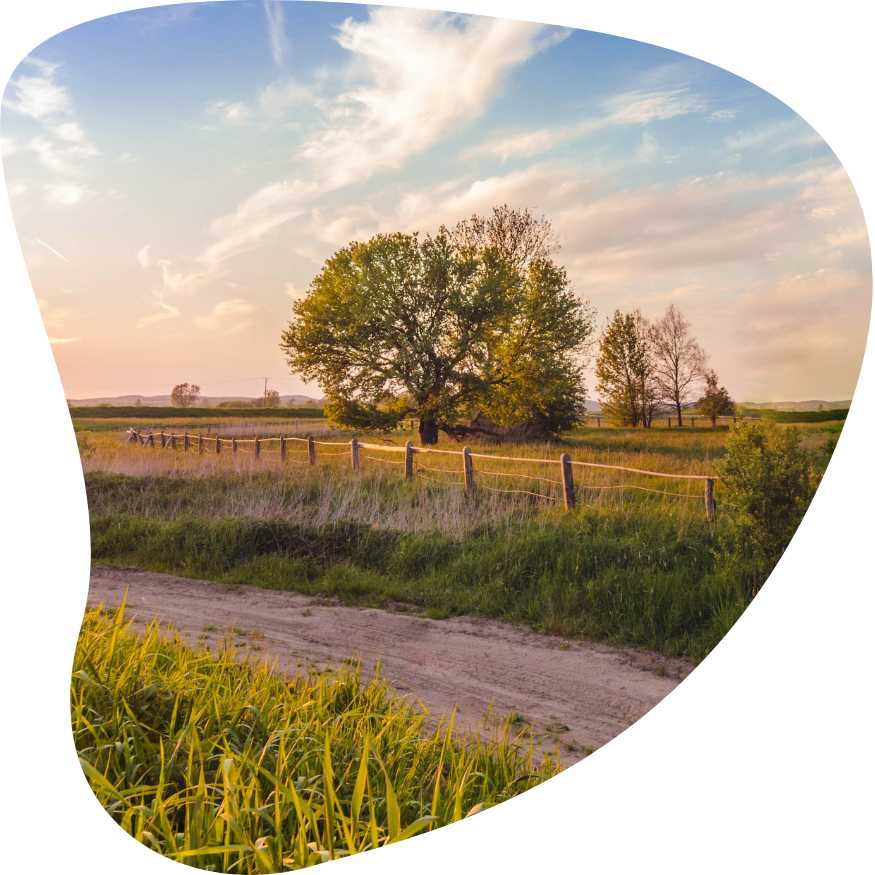What is Biodiversity Net Gain?
Biodiversity net gain is a way to make sure that development can continue across the country, creating safe and secure communities for the future, whilst actively halting and reversing the decline in nature.
It is a key government ambition to leave the environment in a better place than before, as outlined in the Environmental Improvement Plan 2023.
The Environment Act 2021 created the concept of mandatory biodiversity net gain, building on the National Planning Policy Framework’s requirement for net gains in biodiversity to be part of planning decisions.
Projects can achieve biodiversity net gain through three routes: on-site, off-site, or as a last resort buying credits from the government. Developers can combine routes but must do so in consultation with an ecologist, who will be able to confirm that just one route would not be suitable for the project.
Once a developer knows how many units need to be created, they can partner with land managers who have worked to develop the biodiversity value of their land. Any land owner or manager can sell biodiversity units, as long as they meet the requirements. Suppliers of units will be able to work with developers anywhere in the country, provided their use is appropriate for the biodiversity impact of the development. The metric also favours biodiversity nearer the development - so local improvements are worth more.
This is the third and least preferred option, only available once on and off site options have been fully explored. Revenue will be invested by the government in habitat creation. Natural England will run this process and the government’s expectation is that they will be phased out once the market has matured. We expect an indicative credit price to be set 6 months before BNG becomes mandatory.
Finding potential BNG habitats that meet site requirements in the right locations can be challenging.
The Gaia website was useful in setting out options, allowing locations to be filtered by different LPAs, NCAs, and clearly setting out the habitat types available. This was useful in deciding who to approach for quotes.

Andy Reading
Polden Planning
What are Biodiversity Units?
The exact legislation is changing and being updated constantly, but here at Gaia we have broken down the core aspects so that you can understand exactly what it all means and how it might apply to you.
The amount of biodiversity that needs to be generated will be calculated through a Biodiversity Metric and the units of measurement are called Biodiversity Units (you can buy and sell them on the Gaia marketplace).
This is a habitat-based approach to developing a proxy value created by Natural England and is explored in more detail later in this guide. The current version is Biodiversity Metric 4.0. Government anticipates that this will form the basis of the statutory metric which will be laid before Parliament, likely in November 2023.
However the biodiversity net gain is delivered, the biodiversity must be secured for a minimum of 30 years. The government has committed to not reviewing this 30 year time period until at least 2026 to give businesses security of investment.

10% BNG Mandatory From 12th February 2024
The government announced with the 2021 Environment Act that from January 2024 (April 2024 for smaller sites), all development projects must make sure that, as a condition of planning permission being approved, they increase the net gain of the biodiversity of an area by a minimum of 10%.
Gigas
What Does Increasing Biodiversity Actually Mean?
There are two main options, we have habitat creation or we have habitat enhancement/ restoration. The first is taking an area and building out biodiversity that never existed before. The second is taking areas that either used to have or still have existing biodiversity and either restoring or adding to the existing habitat setup.
Broad Habitats
Habitat Types
This categorisation is important because the units a developer purchases need to align with the biodiversity that is disrupted. So if hedgerows are being lost through development, developers would need to purchase the necessary amount of hedgerow units. To find out more about what you need to do see our purchasing guide here.
What is the Biodiversity Metric and How Do You Calculate the Value of Biodiversity Units?
The biodiversity metric is the official tool to calculate the number of biodiversity units required to achieve 10% biodiversity net gain. This is integrated into Gaia.
Use the official BNG metric tool: https://www.gov.uk/government/publications/statutory-biodiversity-metric-tools-and-guides
There are four main factors that the biodiversity metric assesses and we have broken these down below:
Habitat Size
Habitat Condition
Habitat Distinctiveness
Strategic Significance
Biodiversity Net Gain fosters the restoration and enhancement of habitats plus the creation of new ones. Prolonged development and construction without BNG in place has had a detrimental effect on biodiversity and habitats nationwide. Through BNG, species will thrive, and ecosystems will regain their natural balance.
An integral aspect of BNG is habitat creation, wherein developers are encouraged to create wildlife habitats or improve existing ones.
In off-site biodiversity units where habitat delivery is the focus, groups will be investing into neglected landscapes and across the 30 years, will be creating a diverse, flourishing habitat with additional spaces for flora and fauna, resulting in more robust ecological environments.
By preserving and restoring natural habitats, BNG plays a pivotal role in climate change mitigation and adaptation.
Enforcing biodiversity will effectively sequester carbon emissions and directly contribute to carbon offsetting, plus leave us with more and more resilient ecosystems maintained by sustainable development.
The framework allows the country to combine efforts to counter biodiversity offsets and reap environmental and economical benefits nationwide.
By enforcing sustainable development practices, the biodiversity impact will create opportunities for green jobs while supporting industries that prioritise biodiversity, contributing towards long-term economic stability.
It ensures prolonged nature conservation over 30 years by encouraging habitat banks, maintained and monitored by one party for biodiversity preservation.
It also generates long-term financing for habitat maintenance and management, which creates an array of potential jobs. BNG increases the biodiversity value of areas, overall contributing to more economically viable communities.
Why is BNG so important?
Detailed in the environment bill, Biodiversity Net Gain (BNG) is crucial to allow development site projects to continue in a manner that not only avoids harming ecosystems but contributes to their active enhancement.
This creates diverse, beautiful wildlife habitats, greener and more attractive spaces, better air quality, cleaner water, resilient ecosystems and will drastically reconfigure our nation’s contributions to climate change.
BNG, at its core, fosters local nature recovery strategies, and in line with other climate solutions like regenerative farming will protect our natural environment and prevent biodiversity loss for future generations to come.
Key groups affected by Biodiversity Net Gain
BNG is applicable to a broad spectrum of groups across the country, such as land managers, developers, LPAs, ecologists, councils, and construction figures.
Developers will utilise the guidance, plans, and templates provided by the government to navigate how they will undertake sustainable development, and LPAs will crucially assess their BNG Plans and decide to approve these plans in line with climate goals.
Land Managers
Local Planning Authorities (LPAs)

The BNG Process
The soon to be mandatory Biodiversity Net Gain process employs a mitigation hierarchy in a way that will be individualised to each person’s development aims.
A typical process should begin with an initial assessment and identification of key ecological features of the habitat, which can be well-aided with templates, plans and guidance provided by the government websites, Natural England and DEFRA.
Following this begins the development plan, then the biodiversity calculation supported by the statutory metric, the cultivation of the BNG plan that secures habitat monitoring and management, and finally by the LPA assessment.
If approved the developer will obtain planning permission, begin the process and make sure the BNG plan is being met with frequent habitat monitoring.
In off-site BNG delivery, land will formally be secured for 30 years either via Section 106 agreements or a conservation covenant.
As a last resort, developments will undertake the route of biodiversity credits and have to directly approach the government. Though there are various processes, all ensure that future development aligns with our environmental conservation goals.
Biodiversity Net Gain Assessments
When delivering biodiversity net gain, BNG assessments are crucial in determining the effectiveness of biodiversity conservation efforts. These assessments evaluate the ecological impact of development projects, ensuring that the mandated net gain in biodiversity is achieved through comprehensive and sound measures. Assessments are aided by the BNG metric, which calculates the number of biodiversity units of a site and how many are required after development to meet the net objective.
Gigas
Those exempt from BNG
Certain developments may be exempt from mandatory BNG requirements due to their nature or scale, and spatial risks have to be taken into consideration.
At the end of January 2024, the policy comes into place for new builds and from April 2024 it will affect smaller development sites.
There are various definitions of small sites, but crucially, a development fails to take priority if it impacts less than 5 metres of linear site habitats or less than 25m—5m by 5m—of any habitat.
For residential development, you have a small site if you have between 1 and 9 dwellings (a self-contained living accommodation) or it is smaller than 0.5 hectares in site area if the number of dwellings is unconfirmed.
For commercial developments, less than 1,000 metres of floor space is deemed a small site, or if the total area is less than 1 hectare.
Other key exemptions include developments that are going ahead to fulfil others’ BNG plans, advancements within high-speed rail, and any householder applications such as small-project conversions and extensions. Custom, self-build applications are deemed small when less than 9 dwellings and 0.5 hectares.

